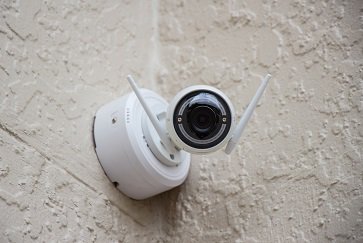Wireless motion-sensing cameras are one of many ways that wireless technology is being integrated into “smart” systems. From industry to retail to city planning and home use, wireless motion-sensing cameras are changing how we work, play, commute, and live.
This blend of old technology like a camera and new technology such as the Industrial Internet of Things (IIoT) is part of a long list of convergence devices reshaping our lives by extending the existing benefits of established technology to new heights.
How Does a Wireless Motion-Sensing Camera Work?
Wireless motion-sensing cameras work using one of three types of sensing. The most common is Passive Infrared Radiation (PIR), followed by Active Ultrasonic and Wi-Fi Motion.
- Passive IR – Passive IR uses detectable changes in infrared radiation to trigger a camera. Everyone generates IR, and the camera is programmed to measure these changes and read them as motion. The camera can then record activity until the motion ceases or a specific amount of time passes. Cameras can be programmed to adjust for ambient changes in IR due to weather or other factors.
- Active Ultrasonic – Active Ultrasonic uses high-frequency ultrasonic waves to detect motion through echo return. Cameras can be triggered when the sound changes enough to alter the echo. However, they may not be ideal for outdoor use or locations where high-frequency ultrasonic waves may interfere.
- Wi-Fi Motion – A relative newcomer to motion sensing, Wi-Fi motion sensing has grown out of the expanding home security environment and is part of the “smart” home suite of technologies. With Wi-Fi becoming standard in most homes, sensors can detect changes in the Wi-Fi signal pattern throughout the house as people, pets, and fans move. This method is a highly accurate way to detect motion and can trigger one or more cameras to record or perform an action within the home.
Beyond the wireless motion sensing to turn the camera on, many cameras come with night vision for enhanced identification and security. They can also be combined with lights that turn on as the camera does.
What are the Main Applications of Wireless Motion-Sensing Cameras?
Wireless motion-sensing cameras can be used in almost any environment: industrial, retail, home, and city planning.
- Industrial Uses – In industrial settings, wireless motion-sensing cameras can be used alongside IIoT technology and advanced analytics to measure and detect quality issues. This combination of technology helps lower quality costs by catching and triggering actions faster than the human eye is capable.
- Retail Environments – Retail environments predominantly use wireless motion-sensing cameras for security. This deployment means fewer resources in the form of human staffing are required in sensitive areas, which lowers operational costs.
- Smart City Systems – Smart cities can take advantage of wireless motion-sensing cameras tied to city-managing IIoT systems. Because cameras are activated as needed, monitoring, intervention, and deployment of resources like first responders can be accomplished by fewer human operators. In many cases, the responses can be triggered automatically.
- Smart Home Systems – Perhaps the place where wireless motion-sensor cameras are recognizable to the average consumer is in the smart home. They can be used for security and may even have night vision. They can also communicate with a central system to adjust temperature, lighting, or start or stop appliances when humans enter or leave. This system helps lower energy costs improves the quality of life.
Finding Resources for Wireless Development
Wireless motion-sensing cameras take old technology and blend it with new technology for an enhanced application. This trend has happened repeatedly as wireless technology has evolved and been paired with advanced analytics and automation.
If you’re an entrepreneur looking to innovate and find new ways to match your technology product, the Henry Bernick Entrepreneurship Centre (HBEC) at Georgian College can help. HBEC offers training programs designed to help entrepreneurs get business plans up and running.
HBEC also has mentorship programs and access to business and academic resources, R&D connections for research and prototype development, and funding for innovative products and companies. Contact us today to find out how we can help.










